Mid-season resistant cabbage hybrid Gloria f1
Perhaps every buyer is familiar with white cabbage Gloria f1, because it can often be found on shelves in retail chains. The article describes what this hybrid looks like, what is good about it and what disadvantages it has, as well as the features of planting and growing the crop.
Description of cabbage hybrid Gloria f1
Like all hybrid forms, Gloria f1 is distinguished by large fruits and high productivity: even from a small plot of land you can harvest a decent harvest.
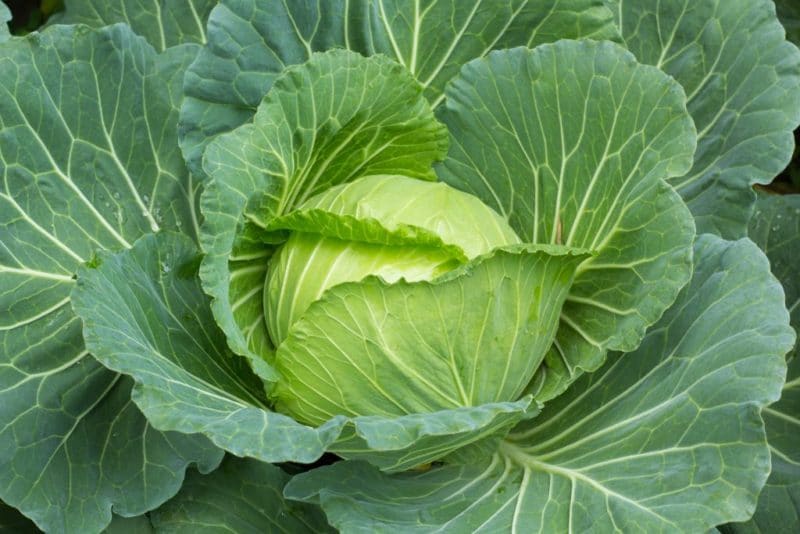
Origin and development
The crop, bred in the Netherlands, came to Russia relatively recently and quickly gained popularity among vegetable growers due to its high adaptability to different climatic conditions and its ability to grow in different regions.
Breeding history
Dutch breeding scientists developed Gloria cabbage in 2005.
Reference. The mid-season hybrid Gloria f1 was included in the State Register of Seed Products of the Russian Federation in 2011.
Chemical composition, trace elements and vitamins, beneficial properties
The product is characterized by high content:
Minerals:
- calcium;
- gland;
- iodine;
- phosphorus;
- potassium
Vitamins:
- A;
- Group B;
- C;
- U.
Important! Thanks to the rare vitamin U contained in Gloria cabbage, consumption of the vegetable helps normalize intestinal function and prevent the development of stomach ulcers.
All parts of the plant, from leaves to roots, have healing properties, have an anti-inflammatory effect and are used for medicinal and cosmetic purposes.
Features of application
The uniqueness of the crop is that it can be sown in 2 terms:
- early sowing is carried out to sell the product in the summer;
- late - for storage and processing for the winter.
Vegetables are eaten:
- fresh - in salads;
- boiled, stewed and fried - in first and second courses;
- The leaves are convenient to use for making cabbage rolls.
Cabbage is prepared for the winter in canned and pickled form; the product does not lose its taste when frozen.
The juice of the plant is used to treat:
- tonsillitis;
- gastritis;
- tuberculosis;
- liver diseases;
- constipation;
- toothache;
- diabetes mellitus;
- tumors and other diseases.
Attention! The juice of fresh and sauerkraut Gloria is an excellent cosmetic product that has an anti-inflammatory effect.
Ripening period
Gloria f1 is a mid-season hybrid, the ripening of which occurs:
- 75-80 days after planting seedlings;
- after 100-120 - with the seedless method, when seeds sown in open ground.
Productivity
The crop gives a high yield: 8-10 kg of vegetables are harvested from 1 m2, while the yield of marketable products is 95-100%.
Disease resistance
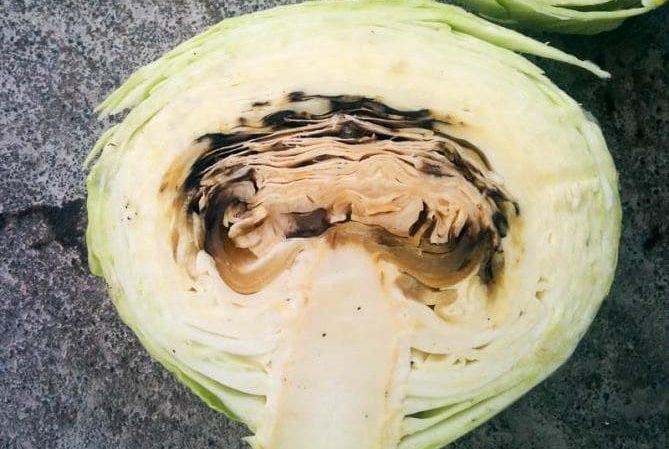
Gloria f1 has increased immunity to a fungal disease - fusarium - which can occur at any stage of the growing season and cause the plant to wilt.
In conditions of high humidity and low air temperature, vegetables are at risk of being damaged by diseases such as:
- powdery mildew;
- gray rot.
Cold resistance
The hybrid successfully develops in different, including cold, climatic zones, and is resistant to differences in day and night temperatures within the range of +20...-6 °C.
Characteristics, description of the appearance of leaves and heads of cabbage, taste
Forks weighing from 2.5 to 4.5 kg, round in shape, have a dense structure (4.4 points on a five-point system).
The leaf rosette is slightly raised above the ground level.
The slightly bubbly, fleshy leaves with wavy edges are green in color with a slight bluish-gray tint, and their surface is covered with a waxy coating.
In cross-section, the head of cabbage is white, with a short inner stalk. Its outer part is of medium length.
Hybrid Gloria f1 has a pleasant, slightly sweet taste and juiciness.
For which regions is it best suited, what are the climate requirements?
The culture is adapted to various climatic conditions and tolerates both short-term drought and low temperatures. At the same time, cabbage does not reduce productivity and does not spoil.
The hybrid is grown in all regions of the Russian Federation, both southern and northern:
- in the middle zone;
- in the North Caucasus;
- in the Urals;
- in Siberia;
- in the Volga region;
- in the Far East.
The main advantages and disadvantages of the Gloria f1 hybrid
The advantages include:
- high yield rates;
- excellent taste of the product;
- attractive appearance;
- versatility of use;
- possibility of growing in different climatic zones;
- low labor intensity of manual and mechanized harvesting work;
- high yield of marketable products;
- good transportability;
- possibility of long-term storage.
Minuses:
- increased demands on the level of illumination of the area;
- the need for regular soil moisture followed by loosening;
- dependence on soil fertility.
Important! A significant drawback of the Gloria f1 hybrid is the tendency of the seedlings to stretch.
What is the difference from other varieties and hybrids
Gloria's distinctive qualities:
- the crop is resistant to fusarium disease and thrips;
- withstands temperature changes;
- does not require mineral supplements;
- vegetables can be sown at two times;
- heads of cabbage are not prone to cracking.
Features of planting and growing
To grow full-fledged forks and get a good harvest, the light-loving crop is planted in an open, well-lit place with fertile soil, observing the rules of crop rotation and following the recommendations for caring for the plant.
Preparing for landing
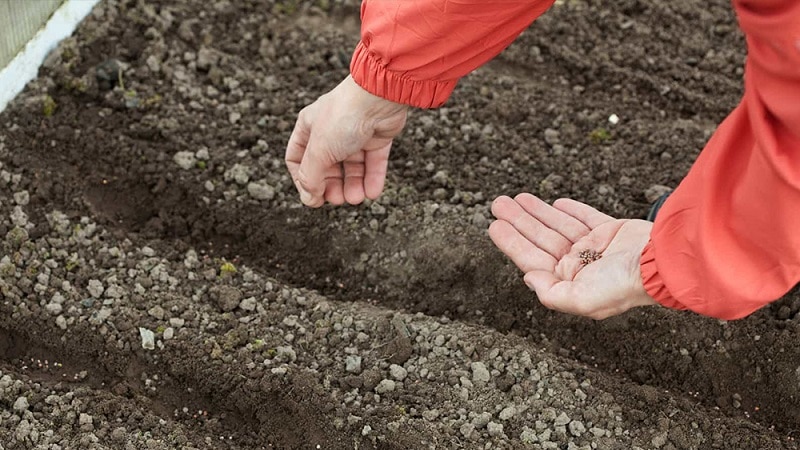
Vegetables are planted in two ways:
- seedlings;
- sowing seeds in open ground.
Seed preparation
Before planting, cabbage seeds are immersed in warm water for 20 minutes and then washed with cool water.
To increase the germination of the seed, it is kept in a growth stimulator solution for 3 hours.
Preparing seedlings
Sowing seeds for seedlings is carried out in the first half of April:
- containers are filled with a nutritious soil mixture consisting of soil and humus or peat;
- seeds are buried 1.5-2 cm;
- moisten the soil;
- covered with transparent film or glass;
- after 5-7 days, when the first shoots appear, the shelter is removed;
- seedlings are kept during the day at a temperature of +14...+18 °C, and at night - at +8...+10 °C, regularly irrigated;
- when 2 true leaves appear, seedlings are picked;
- harden 10-15 days before planting in open ground, taking them out into fresh air first for half an hour and gradually increasing the time to 5-6 hours.
Attention! If the cover from the sprouts is not removed in a timely manner, the seedlings will stretch out and be weak.
Seedlings are planted in open ground in the second half of May, when the soil warms up well and the seedlings reach 15-20 cm in height and 5-7 leaves appear on them:
- prepare holes at a distance of 0.5 m from each other and maintaining 0.6 m between rows;
- 1 liter of water is poured into the wells;
- add a mixture of sand, peat, compost and ash;
- seedlings are placed in holes, covered with soil until the first bottom sheets;
- the soil is slightly compacted;
- To improve growth, plants are shaded for 3-4 days.
The air temperature should remain stable at +12 °C.
How to grow without seedlings
The advantage of planting cabbage by sowing seeds in open ground is that the plants will not suffer from transplantation, which the crop tolerates painfully.
Soil requirements
The plant is not suitable for acidic soils. For successful development, the vegetable needs fertile soil with neutral acidity.
Reference. Gloria f1 grows well on loams that contain humus and easily retain moisture.
Predecessors
The most favorable predecessors for cabbage:
- onion;
- legumes;
- cucumbers;
- roots;
- potato.
It is not recommended to plant the crop after:
- any varieties of cabbage;
- radish;
- tomatoes;
- turnips;
- rutabaga.
Dates, scheme and rules of planting
Seeds are planted in the ground in consistently warm weather with an air temperature of at least +13 °C. Depending on the climate zone, planting activities are carried out in late April - early May.
Planting density and depth
At a distance of 0.6-0.7 m from each other, furrows with a depth of 1.5-2 cm are formed, into which the seeds are sown.
Another option: make planting holes according to the 50 x 60 pattern, into which 5-6 seeds are placed and covered with a 2-3 cm layer of soil.
Important! To speed up the emergence of seedlings, the cabbage bed is covered with agrofibre, and when the first shoots appear, the cover is removed.
Cabbage Gloria F1 - growing features
Growing the Gloria f1 hybrid does not require much effort. Following simple recommendations is enough to reap a good harvest of juicy, healthy forks.
Nuances of care
Caring for the plant comes down to following the watering regime, timely loosening and hilling, applying fertilizers and fighting diseases and pests.
Watering mode
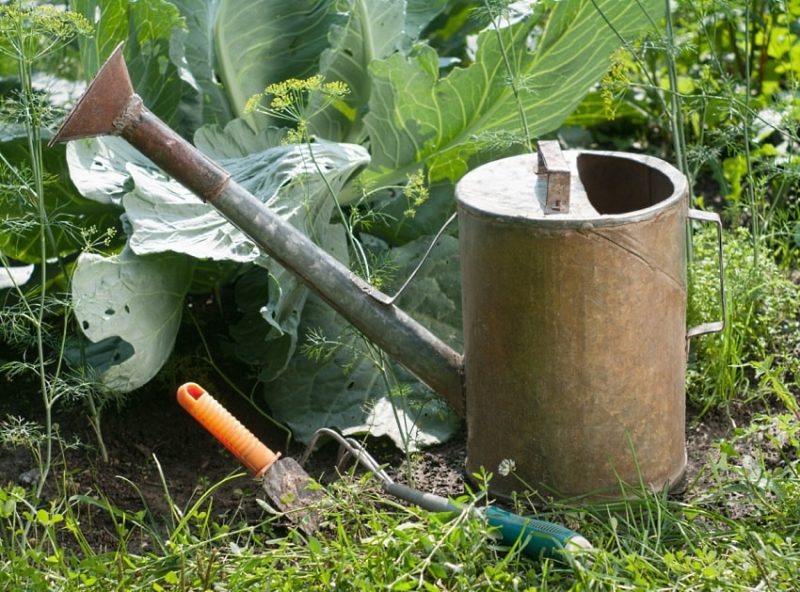
Immediately after planting, the seedlings are watered daily for a week, and then once every 4-5 days, pouring water under the root and trying not to wet the leaves.
In hot, dry times, watering is done once every 2-3 days.
Loosening and hilling
To ensure that the roots of the plant receive a sufficient amount of oxygen necessary for the development of the crop, the soil around the forks is periodically loosened, destroying the crust that forms after watering. Simultaneously with loosening, weeding is carried out, removing emerging weeds.
Once every 14 days, the cabbage is hilled up, rolling the stalks with moist soil.
The hilling procedure ensures:
- improving access to the root system of moisture and nutrients;
- strengthening of young plants, resistance to adverse natural influences;
- protection against the spread of fungal and viral diseases;
- preventing forks from lodging.
Top dressing
Hybrid Gloria does not require the use of mineral fertilizers, but organic fertilizers are necessary to obtain a high yield of vegetables.
Feed the plant three times:
- The first time is when planting, spraying with a solution of ammonium nitrate at the rate of 10 g per 10 liters of water.
- After 14 days, nitrogen-containing fertilizer is applied to actively increase the green mass, dissolving 0.5 kg of chicken manure in 10 liters of water.
- After 2 weeks, when a head of cabbage begins to form, a composition of 30 g of superphosphate; 20 g of ammonium nitrate; 10 liters of water is poured under the root.
Attention! In the case when cabbage seeds or seedlings are planted in pre-fertilized soil, you can refrain from the first fertilizing.
Measures to increase yield
- do not allow excessive soil moisture when watering;
- strictly follow the planting scheme;
- promptly clear the beds of weeds;
- loosen the soil after each watering;
- Hill up the plants regularly.
Disease and pest control
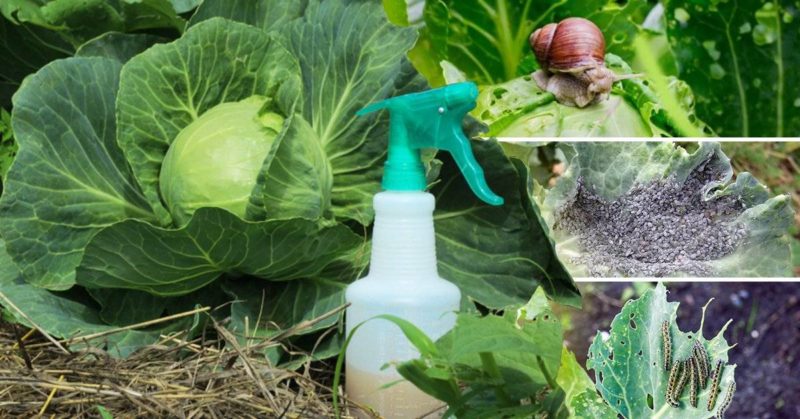
Possessing high resistance to fusarium, the crop is susceptible to a number of other diseases.
Clubroot is a fungus that attacks the root system. Control and prevention measures:
- compliance with crop rotation rules;
- removal of infected seedlings along with the adjacent lump of earth;
- treating the soil before planting with lime at the rate of 1 kg per 4 m2.
Powdery mildew appears as a white coating on the leaves. To combat the fungus, use the biofungicidal agent “Fitosporin-M”, treating the plant once every 14-20 days until the signs of the disease completely disappear.
Gray rot - a fluffy, light-colored mold - affects forks during storage. Treatment of cabbage with the drug “Topsin-M” helps to overcome the disease, and preventive measures consist of:
- timely cleaning of beds from diseased and weeds;
- preliminary disinfection of a room intended for storing vegetables;
- taking care of moderate soil moisture, avoiding excess moisture.
Important! Disinfection of planting material and tools used for cultivating crops is an effective means of preventing diseases of the Gloria hybrid.
Cabbage plantings may also be affected by:
- aphids;
- caterpillars of cutworm butterflies.
Plants planted between rows with a pronounced spicy odor will protect the crop from attack by pests:
- mint;
- nasturtium;
- marigold;
- sage.
The destruction of parasites is facilitated by spraying with insecticidal preparations:
- "Karate";
- "Fufanon-Nova";
- "Iskra-M";
- "Karbofos";
- "Fitoverm".
There are also traditional methods of processing with infusions.
From nettle:
- the third part of the bucket is filled with chopped leaves;
- pour boiling water;
- insist for 2 days.
From onion peels and tomato tops:
- fill a fourth of the bucket with them;
- add hot water and laundry soap;
- leave for a day.
Harvest and storage
Timely collected heads of cabbage Gloria cabbage retains its excellent taste and beautiful appearance throughout the entire storage period.
How and when to collect
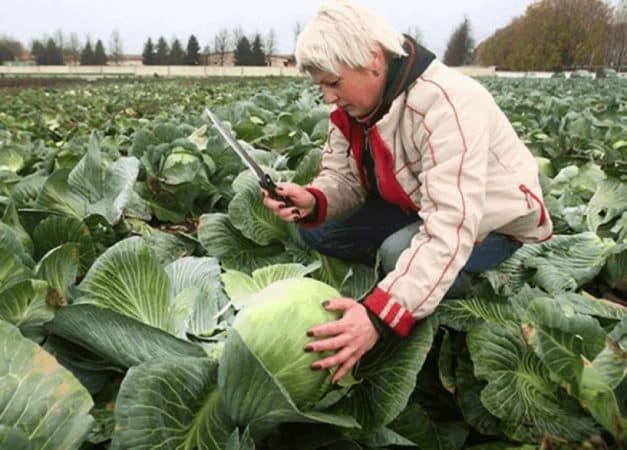
Taking into account the growing region and ripening time when growing seedlings - 80 days, and seeds - 120 days, forks are collected from late August to mid-October.
This is done in clear, dry weather at an air temperature of +3...+10 °C. The heads of cabbage are cut with a carefully sharpened tool - a shovel or knife.
Attention! Before storing the product, the heads of cabbage, which have moisture on the upper leaves, are dried.
Storage features and shelf life of the hybrid
Only the healthiest, strongest specimens, without signs of damage by diseases and pests, are suitable for long-term storage.
The basement or cellar in which vegetables are supposed to be stored must be:
- well ventilated;
- with a relative air humidity of 90-95%;
- with ambient temperature - from 0 to +2 °C.
Store forks on racks, stacking them in 2-3 layers. If there are few heads of cabbage and they have stalks, you can store the cabbage hanging.
The shelf life of a product characterized by high shelf life is 120-150 days.
Important! To increase the keeping quality of the Gloria hybrid, each fork is wrapped in sheets of thick paper.
What difficulties may there be when growing
Lack of sunlight can lead to decreased yields:
- the heads of cabbage grow loose and small in size;
- They do not withstand long-term storage and begin to deteriorate within 2 weeks after harvesting.
Due to untimely or insufficient feeding, problems may arise indicating that the plant lacks the substances necessary for its normal development:
- pale gray color and early death of leaves indicate a lack of nitrogen;
- the appearance of yellowish spots and falling leaves - lack of magnesium;
- transformation of the growth of new leaves and coloring of old leaves creamy - low iron;
- redness of veins and necrosis - phosphorus is needed;
- poor fork development, cupped leaf plates - lack of molybdenum;
- curled edges of sheets, stopping their development - need for calcium.
Excess moisture leads to:
- fruit cracking;
- their wateriness;
- reducing the shelf life of the product.
Lights and reviews from experienced gardeners about the hybrid
Vegetable growers who have been growing Gloria f1 cabbage for several years advise:
- To keep forks especially well, it is better to pull them out by the roots.
- Strictly observe the temperature regime during storage so that the plant does not sprout and bloom during its two-year development cycle.
- Carefully monitor the seedlings to prevent them from stretching.
- It is better to use settled water for irrigation, not cold.
- To retain moisture for a long time, it is recommended to mulch the soil surface around the plants with a layer of peat 5 cm thick.
Important! When growing the Gloria f1 hybrid, keep in mind that the crop tolerates drought much more easily than excessive watering.
Experienced gardeners speak about the hybrid this way:
Alla, Novosibirsk: “Gloria cabbage interested me because of its cold resistance and good yield. The heads of cabbage grow even, with excellent taste. I’ve been growing it for several years, I water and feed it regularly, and I have no problems with diseases.”
Valentin, Voronezh: “I liked the Dutch mid-season hybrid for its good stable yield and resistance to diseases and pests. I believe that whoever decided to grow this variety of cabbage made an excellent choice and will not regret it.”
Conclusion
The Gloria f1 hybrid, bred by Dutch breeders, has gained popularity among Russian vegetable growers due to its excellent taste and high yield. A competent approach to growing the crop, following the rules of planting and care, taking into account the characteristics of the hybrid form, will ensure a full harvest of healthy and tasty heads of cabbage.